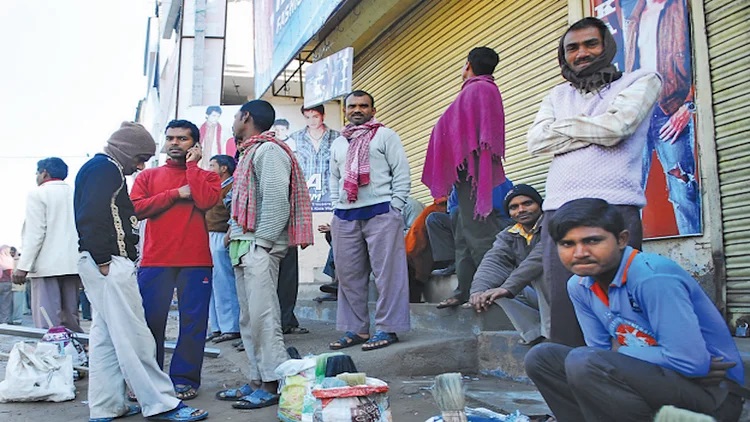India's demographic dividend is at serious risk of turning into a demographic disaster. There are many reasons for this. Poor schooling and training, social unrest, a deepening communal divide and rising majoritarianism are just some of the factors affecting the investment climate and employment opportunities in the country.
The 2011 Census put 58.3% of the population below the age of 29. It came down to 52.9% in 2021 and is projected to decline further to 42.9% by 2036. But while we still have a young population, they are either unemployable or there are just not enough jobs for them.
With India nudging past China as the most populous country next year, as per UN projections, there is growing concern that a demographic disaster is imminent. Mahesh Vyas of Centre for Monitoring Indian Economy (CMIE) remains hopeful though. “This is a once in a multi-generation lifetime period that you get this window, when you have this [huge number] of working age people,” he told IndiaSpend in an interview.
When young and able men and women get employed, their household income, consumption, demand and also savings go up and act as drivers of the economy. So, the focus of government policy should be “ensuring quality, stable jobs that generate savings for a better future”, he added.
Former Union finance minister P. Chidambaram also pointed out in a recent column that jobs are there. Almost a quarter of the Indian population does not own any personal transport, not even a bicycle.
Around 75% of the Indian population cannot afford air coolers or air-conditioners. Smart phones and personal laptops have not reached over 70% of the population. There is clearly a market waiting to be tapped.
While coaching needs of middle-class children are taken care of by coaching factories in Kota and by online platforms for a price, the vast multitude of people studying in rural areas and in government schools are being left behind. There is a demand for good teachers and doctors but the government is unable to process this need and ensure supply.
The Indian Air Force last week made a somewhat triumphant statement that for a mere 3,000 vacancies in the IAF, a record 7.5 lakh youth between 17 and 21 years of age had applied to become Agniveers. The highest est number of applications received in all earlier rounds of recruitment, it said, was 6.31 lakh.
The higher number of applicants demonstrated the popularity of the ‘Agnipath’ scheme, was the underlying message. The number of applicants for government jobs is not surprising because these jobs are seen to provide a semblance of stability, social security and regular pay, if not pension. As seen in the rioting during the railway recruitment, a lot of applicants were overqualified and some with PhD degrees were seen applying for a technician’s position.

The ‘New Age Workforce’, it says, will find work in construction, manufacturing, retail, logistics and transportation. What it doesn’t say is that the jobs would come with low wages, with no social security, insurance or medical facilities and with little or no future prospects.
The loss of salaried jobs in June 2022 alone, said CMIE, was about 2.5 million. While daily wage earners were the worst hit, CMIE data shows that less than 36 percent of the working age population was employed in June.
The World Economic Forum data suggest that close to 13 million people become part of India’s workforce each year. But only one in four are management professionals, one in five are engineers, and one in 10 graduates are employable.
Job losses are a reality. Even start-ups which did the heavy lifting during the pandemic, have now begun to issue pink slips. Over 11,000 employees working in start-ups recently lost their jobs and reports suggest the number is expected to reach as high as 60,000 by the end of the year. Data published by The Indian Express also show that 2.61 crore rural households availed of work under the MGNREGA in May 2022.
Not only was this number higher than the number of households who secured work under the scheme over the same period last year (2.22 crore in May 2021) but is also significantly higher than the pre-pandemic level (2.1 crore in May 2019).
“For a government that takes great pride in India being one of the fastest growing economies in the world, the country does appear to be in a rather precarious position,” says Ajit Abhyankar, economist and activist who believes that the government is intentionally looking away while people continue to suffer.
The private sector, however, claims it is unable to employ people because they are not suitably trained. “If we are to look at India Inc, there is a shortage of skilled labour,” concurs Dr Manoj Kamat, a Goabased academician. Companies are struggling to fill in open positions, he says. “This is a peculiar situation, a complex problem caused by a shortage of skilled workforce,” says the IIT-Bombay alumnus.
The Tourism and Hospitality Skill Council, a not-for-profit organisation promoted by the Confederation of Indian Industry (CII), also claims that the Indian hospitality business is facing a shortage of around 3,50,000 workers. “With business operations normalising and working hours back to normal, the demand for skilled talent is rising,” says Ralph D’Souza of the Travel and Tourism Industry Association of Goa.
Madan Sabnavis, chief economist, Bank of Baroda says, “If unemployment is coming down as the government claims, then there should be a commensurate increase in consumption.” But even in the corporate sector, employment has slowed down, he points out.
The Labour Force Participation Rate— the proportion of those of working age who are seeking jobs—was 47 percent in 2016 and plunged to 40 percent in December 2021. “When we talk of the hospitality sector or malls, are they hiring the same number of people as before? The answer we don’t know but it’s doubtful,” he says.
Sabnavis also holds the ‘Work from Home’ model to have rendered many jobs, like that of an office assistant or a canteen staff, redundant. Banks do not want to open physical branches and want customers to do net-banking and not visit banks.
Barring manufacturing which requires labour participation, in many spheres, technology is pushing out people, he points out. In a country of India’s size, he thinks the increasing trend of leaning on AI and Robotics is dangerous.
Dr M. Govinda Rao, noted economist and member of the 14th Finance Commission explains, “A lot of the growth we have seen is not in employment-intensive sectors.” But in most urban areas you still don’t get a good carpenter or electrician you need, he points out. While he blames it on the dearth of skill, it could also be due to poor demand for their services that good carpenters and electricians have been forced to work as security guards.
It is difficult to say how long it would take the ‘angry, young generation’ of Indians to lose hope or patience. But that the country is inching towards the precipice is more than clear..
































